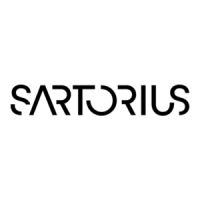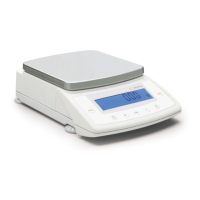
Do you have a question about the Sartorius CPA523S-PCE and is the answer not in the manual?
| Maximum Capacity | 520 g |
|---|---|
| Readability | 0.001 g |
| Calibration | External |
| Display | LCD |
| Interface | RS-232 |
| Power Supply | AC adapter or battery |
| Repeatability | ±0.001 g |
| Linearity | ±0.002 g |
| Weighing Units | g, kg, oz, lb |
| Operating Temperature | 10 °C to 40 °C |
General safety guidelines for operating the balance and preventing damage.
Guidelines for proper installation, including voltage checks and cable precautions.
Guidelines for storing and shipping the balance to prevent damage or issues.
Instructions for unpacking the equipment and checking for damage.
Advice on choosing a suitable location and avoiding negative influences.
Steps to acclimate the balance to room temperature after transport.
Explanation of the control seal for verified balances in the EU.
Steps for installing the CPA2P model, including component placement.
Installation steps for the CPA2P-F model, covering filter pans and standard pans.
Instructions for positioning and securing the draft shield.
Component placement for triangular weighing pans.
Component placement for round weighing pans.
Steps to connect the balance to the electronics box.
Instructions for placing and securing a 3-sided draft shield.
Component placement for rectangular weighing pans up to 10 kg.
Placing the weighing pan for capacities over 10 kg.
Connecting the AC adapter for specific models.
Connecting the AC adapter for balances up to 10 kg.
Information on country-specific power cords for the AC adapter.
Connecting the AC adapter for balances over 10 kg.
Safety information regarding plug-in AC adapters.
Safety information for the universal AC adapter.
FCC compliance notes regarding interference.
FCC statement for Class A digital devices and compliance.
FCC statement for Class B digital devices and troubleshooting interference.
Warm-up requirement for verified balances in legal metrology.
Adjusting the front feet to level balances up to 10 kg.
Adjusting leveling feet for balances over 10 kg.
Identification and explanation of display elements and operating keys.
Key features of the basic weighing function, including taring and printing.
Requirements for using balances in legal metrology.
Specific working instructions for microbalances.
Display symbol meaning and balance power-on procedure.
How to tare the balance and interpretation of the processor symbol.
How to switch the balance off and its stand-by mode indication.
Specific instructions for filter weighing with the CPA2P-F.
Port for below-balance hanger and metrology restrictions.
Steps to prepare microbalances for below-balance weighing.
Definition of adjustment and its purpose.
Requirements for internal calibration after warmup for legal metrology.
Conditions for calibration/adjustment and error messages.
How external calibration is blocked for accuracy class II balances.
Permitted temperature ranges for verified balances.
How to open the Setup menu and key functions for navigation.
How to print current menu settings at different menu levels.
Settings related to weighing functions.
Settings for adapting the filter based on ambient conditions.
Settings for application filters.
Setting the stability symbol display range.
Options for tare function timing.
Enabling or disabling auto zero.
Selection of the first weight unit.
Display accuracy settings.
Configuration of the CAL key function.
Setting the calibration and adjustment sequence.
Selecting weight units for calibration.
Settings for the isoCAL automatic calibration function.
Selection and configuration of application programs.
Selecting available application programs.
Parameters for specific application programs.
Selection of the second weight unit.
Second display accuracy settings.
Storage parameters for specific application programs.
Setting decimal places for calculations.
Setting animal activity levels for weighing.
Options for starting animal weighing.
Parameters specific to the Counting application.
Automatic updating of reference sample quantity.
Settings for the balance's data interface.
Setting the baud rate for data transmission.
Setting the parity for data transmission.
Setting the number of stop bits for data transmission.
Setting the handshake mode for data transmission.
Setting the communication mode.
Configuration options for printing weighing data.
Configuring manual/automatic printing modes.
Options for stopping automatic printing.
Settings for time-dependent automatic printing.
Option to tare balance after printout.
Configuration for printing application parameters.
Configuring printout of application parameters.
Setting the line format for printouts.
Configuring printouts for the net-total program.
Various extra functions and settings for the balance.
Settings for menu parameter accessibility.
Enabling or disabling acoustic signals.
Keypad lock settings.
Configuring external switch functions.
Setting the power-on mode.
Settings for reference balance in counting.
Configuration for ISO/GLP compliant printouts.
Options for resetting menu settings.
Restoring factory settings.
Entering identifiers, setting date/time, and adjusting display brightness.
Key functions for navigating the configuration menu.
Explanation of function keys (F, CF) for application programs.
Application programs on legal measuring instruments and indicated values.
Menu code for Net-total Formulation.
Features of Net-total Formulation: weighing components, storing, clearing, toggling.
Example printout format for net-total formulation data.
Menu code for the Counting program.
Features of the Counting program: minimum load, setting reference quantity, resolution, auto output.
Explanation of function keys (F, CF) for the Counting program.
Steps to change and store the reference sample quantity.
Using a reference balance for higher precision in counting.
How to transfer reference values.
Example of a counting printout.
Menu code for Weighing in Percent.
Features of Weighing in Percent: reference weight, storage, decimal places, auto output.
Explanation of function keys (F, CF) for Weighing in Percent.
Steps to change and store the reference percentage.
Example printout for Weighing in Percent.
Menu code for Animal Weighing/Averaging.
Features of Animal Weighing: manual/automatic start, load thresholds, auto start, animal activity, operations.
Explanation of function keys (F, CF) for Animal Weighing.
Steps to change and store the number of subweighing operations.
Example of an animal weighing printout.
Menu code for toggling weight units.
How to configure the application for toggling weight units.
Function key for toggling between weight units.
Generating printouts automatically or manually, line format, app parameters, ISO/GLP printouts.
Default factory settings for printout modes.
Line format options for printouts.
Configuring printout of initialization values.
Settings for ISO/GLP compliant printouts.
Settings for automatic printout of weight values.
Reference to configuration for printout settings.
Examples of printouts without data ID codes.
Examples of printouts with data ID codes.
Generating printouts of configured initialization values.
Examples of automatically printed weight readouts.
Parameters included in GLP header and footer.
Menu code settings for ISO/GLP printouts and line format.
Using function keys to output header and reference data.
Example lines in an ISO/GLP compliant printout.
Example of printout for external calibration/adjustment.
Interface type, operating mode, standard, transmission rates, parity, format, handshake.
Default factory settings for interface parameters.
Reference to pin assignments and charts.
Identifying non-verified digits on printouts.
Characters output during normal operation.
Special codes used in data output.
Codes displayed for error conditions.
Meaning of ID code characters.
Example of data output with ID codes.
Meaning of ID code characters.
Table of meanings for ID codes.
Formats for sending control commands to the balance.
Explanation of command characters and their meanings.
Parameters for data communication and synchronization.
Handshake parameter options for the balance interface.
Control of software handshake via XON/XOFF.
Transmitting print commands.
Automatic data output modes and settings.
Information on requiring faster output speeds.
Connector details for the female interface.
Specifications for the male connector.
Warning about incorrect pin assignments in RS-232 cables.
Detailed pin assignments for the interface connector.
Table mapping display issues to causes and solutions.
Table mapping causes to solutions for display issues.
Table mapping display issues to causes and solutions.
Table mapping causes to solutions for display issues.
Information on Sartorius service contracts.
Guidelines for authorized repair work.
Caution regarding battery replacement and disposal.
Instructions for cleaning the balance and its parts.
Specific instructions for cleaning stainless steel parts.
Information on proper disposal of packaging and equipment.
Sartorius AG's role in equipment disposal.
Contact information for disposal in EEA countries.
Guidance for disposal outside the EEA.
Instructions for battery removal before disposal.
Optional data printer with advanced functions.
Optional reflective remote display.
Optional external battery pack for extended use.
Optional carrying cases for different balance types.
Software for data transfer to applications.
Optional kit for density determination.
Optional antistatic weighing pan.
Calibration weights available with DKD certificate.
SOP for optimal balance use in quality management.
Industrial AC adapter for capacities up to 10 kg.
Industrial AC adapter for capacities over 10 kg.
Optional analytical draft shield chamber.
Optional draft shield cover with opening.
Data cables for PC connection.
Adapter for connecting D-Sub connectors.
Remote control switch for balance functions.
T-connector for peripheral devices.
Optional hanger for below-balance weighing.
Optional weighing bowls of various volumes.
Optional dust covers for display units.
Regulations for weighing instruments in legal metrology.
Information on EC Type-Approval Certificates.
EC verification process by manufacturer.
Sartorius' compliance with EC directives.
Reference for CE mark information.
Services included in new installation package.
Sartorius' EC verification service.
Validity of verification and obtaining contact information.
Contacting the Service Center for verification information.
Markings on various balance types.
Alternative external electronics for BC BL 100.
View of the back panel with markings.
Location of the menu access switch.
Meaning of the 'K' marking for CE conformity.
Meaning of the 'M' marking for EC verification.
Meaning of the 'S' marking for protective seals.
Meaning of the 'MD' marking for metrological data.
Meaning of the 'T' marking for model designation.











